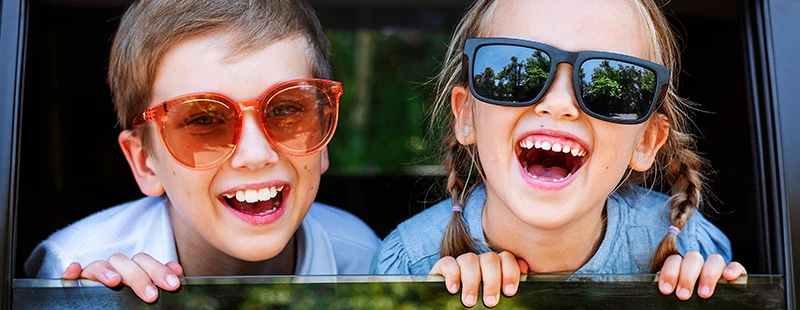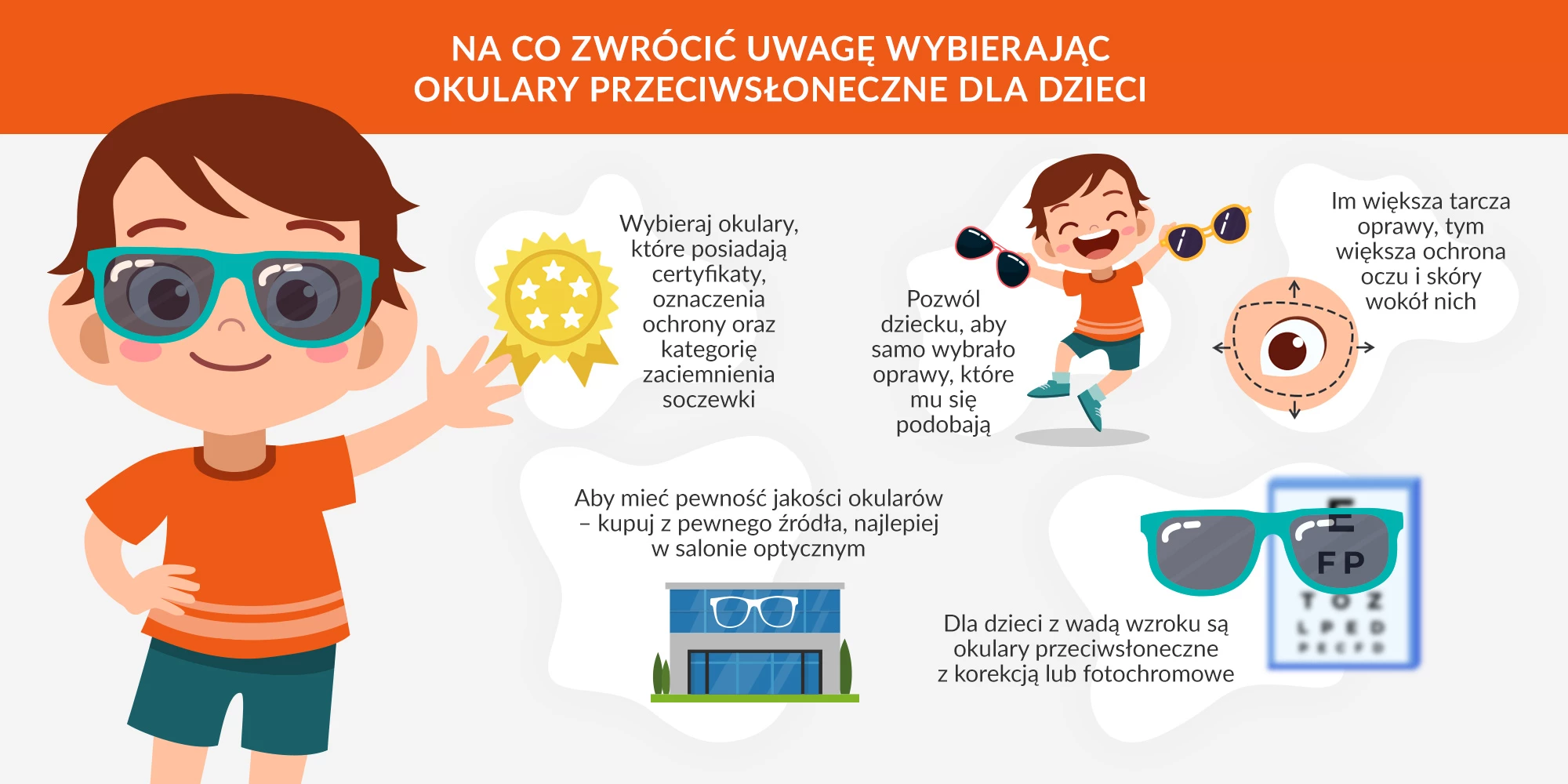We all know that ultraviolet radiation (UV) has a major impact on how we function. It is worth reminding ourselves, especially now in spring, that sun exposure conditions the correct synthesis of vitamin D3 and activates the production of melatonin, which acts as a natural sunscreen.

The sun has a huge impact on our mood and well-being (production of the hormone of happiness!), but it can also be good for the skin - especially skin with problems. UV radiation is used in the treatment of diverse skin conditions, such as psoriasis and atopic dermatitis.
Contents:
2. Sunglasses for children - how to choose them?
3. Good sunglasses for children
Eyesight and UV radiation
The sun is essential to our physical health and mental well-being. However, "enough is enough". Overexposure to the sun is also a danger (who has ever gotten a sunburn in their life?). However, we often forget about the eyes, which are particularly sensitive to harmful UV radiation. Eyes and eyelids are exposed to UV radiation all the time, whatever the weather, time of day or year. It reaches all the structures of the eye, where it accumulates throughout life from early childhood.
Short-term exposure to the sun can result in general discomfort, temporary visual disturbance and inflammation of the cornea and conjunctiva accompanied by tearing, a feeling of sand under the eyelids and photophobia. Whereas long-term exposure to UV radiation can lead to development of pathological changes such as cataracts and macular degeneration.
Sunglasses for children - how to choose them?
Children's eyes are particularly vulnerable to the harmful effects of UV radiation. As you know, kids spend much more time outdoors than adults. In addition, it is good to know that a young child's lens is perfectly clear and provides almost no protective barrier. It transmits about 75 percent of all UV radiation that reaches deep into the eye up to the retina. Additional eye protection is necessary, and it can be provided by sunglasses with filters.
It is rather impossible to use sunglasses in the case of newborns and very young children. In such situations, parents can protect their child by using suitable headgear, a canopy or umbrella for prams. Keep it in mind that not only direct sunlight is harmful but also radiation reflected from the surface of water, snow or sand. In older children, the most effective form of protection is glasses with a UV filter, which is placed on both clear and tinted corrective sun lenses.
What to look for before buying sunglasses for children?
When choosing sunglasses, parents should pay attention to several important aspects:

- Children's sunglasses should be certified and marked with the type of protection applied (CE 100%UV or UV400) and the category indicating the level of darkness of the lens (from 0 to 4). For children, category 3 is recommended, which reduces the amount of light falling on the lens by 82-92%.
- It is extremely important to buy glasses from a reliable source, preferably an optical showroom. Sunglasses that do not have adequate protective coatings pose a very high risk to the eye. A dark spectacle lens causes the pupil to widen, which increases the amount of light, which also increases the amount of harmful radiation reaching the depths of the eye. You should always remember - using the wrong glasses is far more dangerous than not wearing them at all. In addition, sunglasses lenses of poor quality can also impair visual comfort by causing distortion (which usually leads to worse, distorted vision, headaches and eye pain or pinched eyes).
- When choosing sunglasses, you should also pay great attention to the type of frame and its fit. Plastic frames without metal parts and delicate nosepieces are most suitable for children. The larger the shield of the frame, the greater the protection for the eyes and the skin around them. The most important thing is that the child themselves choose the glasses they like. thanks to that they are most likely to accept them quickly and use them willingly.
Good sunglasses for children
Apart from classic sunglasses optical showrooms offer a multitude of interesting solutions that protect the eyes against harmful radiation.
- Frames with interchangeable sun protection caps or fixed tinted lenses are recommended for children.
- There are also photochromatic lenses which tint according to the intensity of UV radiation (transparent indoors and dark outdoors).
- Dark sunglass lenses, in addition to UV filters, may have additional coatings to improve visual comfort. The polarised coating eliminates blinding glare from highly reflective surfaces such as water or asphalt and is particularly useful for active holidays by the water and in the mountains, especially in winter. It is worth knowing: It is very easy to check if your sunglasses have the polarisation effect - you look at the phone you are holding in your hand and then rotate it 90 degrees. If we can still see what is displayed on the phone screen it is a sign that such glasses are not polarised. The complete darkening of the image in front of the glasses means that the lenses are polarised.
- Protection against harmful UV radiation can also be found in contact lenses, but it is much weaker than in spectacle lenses. This is because contact lenses do not protect the conjunctiva or eyelid skin. Those who wear contact lenses are advised to use sunglasses as an addition.
The Acuvue Oasis with Transitions lenses, which help the eyes adapt to changing light conditions, have recently been launched on the market. Under the influence of UV and blue light, the internal structure of the contact lens changes and, as with a photochromatic lens, it becomes darker.
Unfortunately, however, climate change on Earth is progressing, and we have to contend with the effects of the ozone hole. We may not remember it every day, but exposure to harmful ultraviolet radiation continues to increase. The WHO and the International Commission on Non-Ionizing Radiation Protection (ICNIRP) recommend full UV protection (i.e., the use of glasses with a UV filter of 400, which filter out practically 100% of UV radiation). Children should be made aware from an early age that protecting the eyes from harmful radiation is just as important as protecting the skin, and that sunglasses, like SPF sunscreen, should become a part of our everyday lives, regardless of the season.
By:
Ewelina Guzek, Optometrist, Medicover Optyk
Added on 27.05.2021



